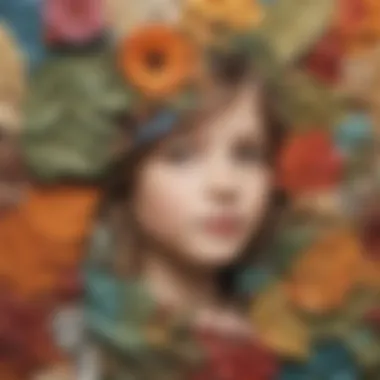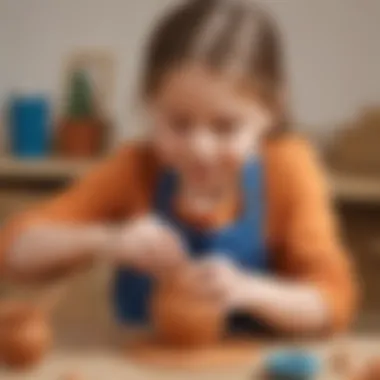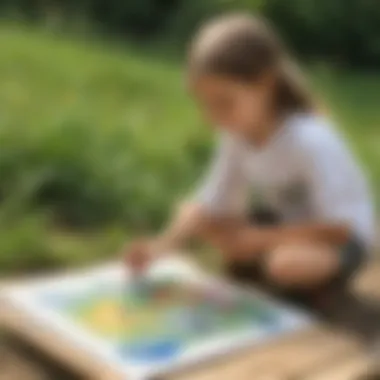Innovative Art Activities for 7-Year-Olds: Cultivating Creativity


Intro
At the age of seven, children exhibit remarkable potential for creativity and skill development. This article focuses on diverse art activities tailored for this crucial stage, presenting opportunities that engage children while encouraging their growth. Integrating different mediums helps cultivate a holistic artistic experience. Parents and educators can employ these activities both at home and in the classroom. Art is not merely a pastime but a pathway to cognitive engagement that nurtures individual expression.
Fun Activities Ideas
Engaging children in art requires creativity as well. A variety of activities exist, appealing to different interests and preferences. Here are some ideas structured into several categories:
Indoor Activities
Indoor activities are essential, especially when weather is not conducive to outdoor fun. They provide a rich setting for elaborate arts and crafts that sharpen fine motor skills and encourage creativity.
- Drawing and Coloring: Suitable for all ages, drawing fosters imagination. Provide different materials such as colored pencils, markers, or watercolors to keep the experience dynamic.
- DIY Art Projects: Use recyclable materials like bottle caps and empty boxes to create unique craft items. Children love transforming everyday trash into treasure.
- Playdough Sculpting: Making figures with playdough allows for sensory exploration. While shaping, kids are developing not only creativity but their cognitive skills.
Outdoor Adventures
Outdoor painting can break the monotony of traditional mediums. Experiencing nature allows children to collect inspiration right where they are. Some outdoor activities include:
- Nature Walks: Lead a walk where kids gather natural materials such as leaves, rocks, and flowers. These can serve as inspiration or be used in collages.
- Chalk Art: Sidewalk chalk lets children express themselves without traditional constraints found in the classroom environment.
Arts and Crafts
Arts and crafts comprise a significant segment of artistic engagement. These activities encourage curiosity and creative risk-taking.
- Mosaic Making: Use small pieces of colored paper or glass to create a larger design.
- Collage Competition: Children can create themed collages, fostering teamwork and creativity.
Science Experiments
Science and art intersect in exciting ways. Simple experiments yield artful and educational results. For example:
- Making Volcanoes: Kids can create geological structures while exploring chemical reactions using vinegar and baking soda. The output is both impressive and igniting curiosity about science.
Cooking and Baking
Artistry can even be found in the culinary realm. Planning simple recipes helps children appreciate the role of creativity in various disciplines. Crafting edible art allows for a relaxed, yet meaningful experience.
- Decorating Cupcakes: Using icing and toppings transforms baking into an art form.
- **Fruit Sculptures:**These are easy to make and can serve both as snacks and playful art.
Overall, these play opportunities blur the lines between art and other functions.
Prelims to Art Activities for Children
Art activities hold profound significance in the realm of child development, especially for seven-year-olds. At this pivotal stage, children enhance their motor skills, and cognitive functions while discovering avenues for self-expression. By participating in art projects, children not only learn to manipulate materials but also engage in problem-solving and develop critical thinking skills. Understanding the nuances of how art activities can be aligned with broader developmental needs is crucial for parents and educators alike.
Art nurtures creativity by translating ideas into tangible forms. It allows children to articulate their understanding of the world, providing them tools to communicate feelings or concepts which may be difficult to express through words alone. Using various mediums encourages exploration, facilitates imaginative play, and promotes a sense of achievement as they produce their creations. This sense of accomplishment not only builds confidence but also reinforces their desire to take risks in future artistic endeavors.
Educators and parents can guide children through enriching artistic experiences. Careful selection of activities can align with educational principles, allowing for skill enhancement in a captivating manner. Therefore, incorporating art in educational settings or homes enriches the child's growth, addressing not only creative but also cognitive and emotional development through constructive play.


Understanding the Significance of Art in Childhood Development
Art serves as a fundamental element in childhood development. It influences various domains, including social, emotional, cognitive, and physical growth. Engaging in art boosts fine motor skills through the manipulation of art supplies, such as brushes and clay. These activities help strengthen hand-eye coordination and decision-making abilities, which are crucial for tasks in the everyday life beyond the art space.
Moreover, the act of creating art fosters emotional intelligence. It offers children the opportunity to explore and communicate complex emotions; they can channel their feelings into the creation process rather than confining them to verbal expression. Art can also cultivate empathy, as children may learn to appreciate what others express through their work.
Albert Einstein once said, "Creativity is intelligence having fun." This emphasizes the significance of foster creativity. Engaging children in arts can lead to cognitive flexibility, creativity, and innovative thinking— .. skills highly regarded in our increasingly dynamic world.
What Makes Art Engaging for Seven-Year-Olds?
At seven years of age, a child's curiosity intensifies, creating an innate desire to explore and learn. This time often marks a development phase where children feel a burgeoning knack for creativity While it plays a significant role, various elements can contribute to making art engaging for children.
- Variety of Materials: Children get excited when given new and diverse art supplies. Different colors, textures, and tools invite exploration and experimentation, appealing to their tactile impulses.
- Hands-On Process: Children prefer activities where they can physically engage, allowing them to get their hands dirty with paint or clay. This tactile experience makes art a compelling and multisensory endeavor.
- Self-Expression Value: At this age, children are beginning to develop their sense of identity. Art becomes a medium for sharing personal narratives, a chance to visually represent their thoughts, concerns, and imaginations.
- Social Interaction: When art is done in group settings, children find joy in sharing experiences with peers, providing a collective atmosphere that enhances enthusiasm for their projects.
- Open-Ended Projects: Children enjoy projects that allow stem forming of their ideas rather than giving them rigid guidelines. This autonomy fosters a deeper sense of connection with their work.
Through scaffolding, guides and support, not only are skills developed, but engagement afterward can evolve into sustenance of lifelong creativity. Teachers and parents encouraging creativity today is building adults with magical skill sets of thinking fully tomorrow.
Exploring Different Art Mediums
Exploring different art mediums is essential for nurturing creativity in seven-year-olds. At this developmental stage, children are eager to experiment and express themselves. Engaging with various media helps them discover interests and preferences while building crucial skills. It promotes sensory exploration and introduces new, practical techniques, laying a strong foundation for artistic experiences.
Drawing and Painting
Benefits of Drawing for Cognitive Development
Drawing fosters essential cognitive development in children. It enhances hand-eye coordination and fine motor skills. As kids draw, they engage their brains in ways that improve spatial awareness and visual memory. This activity encourages critical thinking and observation. Drawing is an effective way to express feelings and thoughts. Importantly, it also motivates children to communicate visually, providing them tools for storytelling through images. Thus, it is highly relevant in the context of supporting artistic expression.
Painting Techniques Suitable for Young Artists
Painting allows for color exploration and creativity in a very tactile way. Techniques such as finger painting or watercolors can be very stimulating for young artists. These methods give freedom to create without the constraints often felt in more structured forms. Painting teaches children about color mixing and texture, allowing them to see immediate results of their choices. Young artists get the satisfaction of producing something visually stimulating, which builds their confidence in trying new things.
Collage and Mixed Media
Creating Textured Artwork
Textured artwork through collage provides myriad opportunities for exploration. Children can use materials like fabric, paper, and natural objects to form compositions. This method nurtures creativity while allowing kids to feel and see the details. The collaging activity encourages material exploration and enhances sensory awareness. Young creators can gain an appreciation for fitting different elements together, learning that art sometimes combines unexpected components to tell a story.
Mixing Traditional and Modern Materials
When mixing traditional art materials with modern supplies, children experience boundaries of creativity pushed. Ingredients like recycled items, electronic scraps, or digital tools broaden their artistic horizons. The juxtaposition of various sources sparks imaginative endeavors. This merging of styles encourages kids to think critically about the art forms they encounter in everyday life. However, the challenge might be overwhelming without appropriate guidance. Finding balance ensures an engaging yet manageable activity.
Sculpting and Three-Dimensional Art
Working with Clay and Dough
Clay and dough sculpting ignites children's imaginations. The malleability of these materials provides control and options for artistic experimentation. While forming three-dimensional pieces, children experience the intersection of tactile exploration and design. Working with clay educators emphasizes not just creativity but also spatial reasoning which is invaluable. Young artists learn concepts like balance and proportion that can transfer into many other learning areas.
Recycling Materials for Sculptures
Recycling materials allows children to give new life to old objects. They learn the concept of sustainability paired with creativity. By using junk or waste, they explore creative potentials hidden in everyday items. This activity teaches the value of resourcefulness while fostering ingenuity. The practice highlights environmental responsibility, an important lesson for new generations.


"Art is not what you see, but what you make others see." - Edgar Degas
Each of these mediums empowers seven-year-olds in their artistic journey. Through hands-on experimentation and exploration, children not only gain skills but discover joy in creative endeavors. The integration of innovative art activities in their lives ensures a rich tapestry of learning and growth.
Incorporating Educational Elements
Art is not just a form of expression; it is also a powerful educational tool that can reinforce vital skills. Incorporating educational elements into art activities for seven-year-olds encourages not only creativity but also cognitive growth. When children engage in art, they also learn problem-solving, critical thinking, and fine motor skills that are essential for task completion in various endeavors.
By merging art with educational components, it becomes more purposeful. This section will explore how art can serve as a bridge to enhance both STEM subjects and language skills. The goal is to create a comprehensive framework where education is seamlessly integrated into art activities.
Art Activities that Promote STEM Learning
Connecting Art with Science Concepts
One primary advantage of connecting art with scientific concepts lies in its ability to make abstract ideas more tangible. By visualizing scientific principles, such as the water cycle or plant growth, children can solidify their understanding and retention of these concepts. One engaging activity might involve having children create a visual representation of the lifecycle of a butterfly. Here, students can use various art methods, such as painting or collage, to depict life stages accurately.
- Key Characteristic: Visual representation enables children to grasp complex scientific ideas.
- Popular Choice: Recommended, as it draws on both creativity and academic learning in an engaging manner.
- Unique Feature: Integration of art makes science more approachable and fun.
- Advantage: It fosters curiosity through creative questioning and exploration.
- Disadvantage: Some children might struggle with the complexity and require guided support.
Physics in Sculpture Building
Another fruitful art activity connecting with science is construction using principles of physics. When children create sculptures or models, they apply their understanding of balance, gravity, and structure. For example, making a tall structure from materials like clay or recycled items challenges them to consider how weight and balance affect the structure. This directly incorporates problem-solving, as children must figure out how to strengthen their sculptures against potential collapse.
- Key Characteristic: Applications of physics highlight essential scientific theories in practical forms.
- Popular Choice: It broadens children's understanding of the physical world as they become more aware of mass and structure.
- Unique Feature: By engaging with 3D elements, they learn spatial awareness.
- Advantage: Encourages persistence as they test and adjust their creations to achieve stability.
- Disadvantage: If planning is flawed, that can lead to frustration and drop in motivation.
Integrating Language Skills through Art
Art can also serve as a fertile ground for enhancing language skills among young children. When kids engage in creative projects that involve storytelling or expression of ideas, they practice various linguistic components such as vocabulary, grammar, and comprehension. This section will discuss how storytelling through art can lay vital language foundations that support overall communication abilities in future years.
Art Projects that Involve Storytelling
Engaging in art projects that necessitate storytelling serves both creativity and articulation. For instance, creating illustrated books or comic strips involves narrating a story while simultaneously drawing or painting. This approach not only enriches vocabulary. It prompts children to think critically about their narratives, how to structure them, and how to use art to reinforce their messages.
- Key Characteristic: Merging narrative and visualniques spotlight creative literature skills in practical ways.
- Popular Choice: This method is well-liked as it gives children the freedom to express themselves creatively while building essential writing skills.
- Unique Feature: Interaction encourages discussion from their work, boosting conversational skills and confidence.
- Advantage: Creation of unique stories promotes individual expression and critical thinking.
- Disadvantage: Some children may feel daunted by the storytelling aspect, which requires varying levels of guidance.
Encouraging Descriptive Language Through Art
Another crucial aspect is using art to cultivate descriptive language. When children explain their artworks, they explore their feelings and ideas uniquely. A relevant activity might be having children create “artist statements” for their pieces. By articulating their artistic choices and feelings about the work, kids hone their ability to use specific language creatively.
- Key Characteristic: Urges articulation of complex ideas through engaging methods.
- Popular Choice: It is common since it allows children to connect emotions and language quality, grounding them in expression.
- Unique Feature: Direct interaction makes arts fit for public sharing.
- Advantage: It fosters public speaking and relational skills as they discuss their work with peers.
- Disadvantage: Some kids may be hesitant to share their thoughts, emphasizing the need to create a safe and stimulating work environment.
The interplay between art and education is essential for growing curious and competent learners. Nurturing these skills through innovative activities both broadens creativity and reinforces academic learning.
Practical Tips for Parents and Educators
Supporting seven-year-olds in their artistic endeavors involves more than merely providing supplies. It encompasses enhancing their environment and approach during art activities. The information outlined here serves to guide parents and educators in crafting experiences that stimulate creativity and develop essential skills. Analytical thinking and emotional expression thrive better when children are nurtured in a supportive atmosphere.
Setting Up an Art Space at Home
Essential Supplies to Keep on Hand


Having a readily available set of art supplies not only simplifies the artistic process but also encourages spontaneity in creativity. Essential items commonly include washable markers, watercolor paints, colored pencils, and various types of paper. Each of these contributes differently:
- Washable Markers: Ideal for young ones; they allow for clean and worry-free use.
- Watercolor Paints: Teaching mixing colors helps understand visual design and improve fine motor skills.
- Colored Pencils: Versatile for detail work, letting children explore shading and texture.
- Paper of Various Types: Practicing on different surfaces teaches adaptability in styles and techniques.
These supplies should be prominent and organized. An accessible inventory encourages children to select resources themselves, giving them more control over their creative process.
Collaborative Art Projects
Collaborative art projects are more than just fun activities for young children. They provide essential opportunities for creativity while helping to develop social skills. Working together fosters a sense of community among children, introducing them to diverse perspectives and ways of thinking. This process is crucial as it not only enhances their creativity but also fortifies their abilities to communicate, compromise, and resolve conflicts while they create.
Group Activities in Classrooms
Benefits of Teamwork in Art
Teamwork plays an important role in art projects for seven-year-olds. Collaboration encourages children to share ideas freely. Each child brings a unique viewpoint, enriching the artistic experience. This exposure promotes adaptability and resilience. They learn to listen to each other, which increases their social and emotional awareness. Additionally, creative collaboration can reduce feelings of competition among peers, fostering a more supportive environment. While potential challenges exist, the overall benefits make teamwork in art a popular choice in classrooms. Children consistently express more satisfaction and enthusiasm when part of a group effort.
Example Projects for Class Collaboration
Example projects that encourage class collaboration are essential for demonstrating practical applications of teamwork through art. For instance, a mural project can unite a class in creating a large canvas that reflects their individual perspectives. This project strengthens their creative muscles while addressing essential life skills, such as conflict resolution and compromise. Moreover, using specific class themes such as history or culture can make art more engaging. Real-world subject matter boosts interest and adds educational value to the artistic expression. Although group projects might take initial coordination, the resultant rich tapestry of ideas is worth the effort and discussion.
Family Art Projects
Family art projects connect multiple generations through shared creative experiences. Driving creativity at home, these activities present a platform for children to associate art-making with family values. Simple tasks like creating family collages from old magazines build bonds through storytelling. Discussing each person's chosen images provides opportunities for greater interaction and understanding within the family unit. It offers children the space to express their feelings and thoughts closely with relatives, creating lasting memories. Families can also uncover hidden artistic talents and perspectives, enriching the experience further.
Effective communication through art can strengthen family ties while providing a roadmap for important discussions on values and beliefs.
Establishing meaningful dialogues during these activities can pave the way to genuine connections. Overall, collaborative art projects delight, educate, and connect participants through shared creativity.
Finale: Nurturing Creativity Through Art
Art activities for children, particularly seven-year-olds, play a crucial role in their personal and academic development. Focusing on creativity through these activities nurtures their capacities not just in artistic senses, but in problem-solving, critical thinking, and interpersonal skills. As children embark on their creative journeys, they process their experiences and emotions through art. This plasticity is valuable and forms a solid base for later learning.
Engaging children in art fosters a sense of exploration and innovation that extends beyond the canvas.
The Long-Term Benefits of Engaging in Art Activities
Engaging in art activities now provides pivotal long-term benefits. Children who regularly participate in creative exercises often develop superior communication skills. They learn to express ideas clearly and effectively through visual formats. Furthermore, art enhances fine motor skills through varied practices like drawing and shaping. Thus, children enhance their peer interactions, managing collaborative work and feedback.
Consistent participation in art activities also targets cognitive growth. Children typically develop enhanced observational skills. This leads to better analytical thinking and increased creativity. Cognitive benefits extend beyond the arts as these skills translate to improved academic performance across subjects.
Some additional benefits include:
- Boosted Self-Esteem: Creating art helps children take pride in their accomplishments.
- Adaptive Thinking: Artists frequently encounter unexpected issues, fostering adaptability.
- Emotional Regulation: Art allows for the expression and processing of complex emotions.
Encouraging Lifelong Creative Pursuits
To cultivate a lifelong relationship with creativity, it is essential to encourage children to continue engaging with art as they grow. Providing a sensory-rich environment where experimentation is praised will nurture their creative spirits. As they evolve, they will likely find their unique voice.
Parental involvement also remains influential. Engaging in art together creates shared memories and establishes a positive association with creative activities. Utilizing community resources like art camps or workshops can expand their vision and fuel inspiration beyond home settings.
Further factors that support ongoing creativity include:
- Setting Realistic Goals: Break down projects into attainable components to minimize frustration.
- Valuing Process Over Product: Shift focus to enjoyment rather than perfection.
- Encouragement: Praise effort and uniqueness, fostering an environment that celebrates diversity in creativity.
By recognizing and understanding the immense benefits tied to artistic engagement, parents and educators can guide children toward a fulfilling journey in the world of art. This ongoing support is integral to forming a passion for creativity that will anchor their pursuits throughout their lives.



